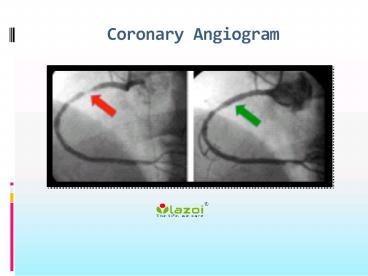Coronary Angiogram (1) PowerPoint PPT Presentation
Title: Coronary Angiogram (1)
1
Coronary Angiogram
2
What is coronary angiogram?
- A coronary angiogram is a procedure that
uses X-ray imaging to see your heart's blood
vessels. The test is generally done to see if
there's a restriction in blood flow going to the
heart. - Coronary angiograms are part of a general group
of procedures known as heart (cardiac)
catheterizations. Cardiac catheterization procedur
es can both diagnose and treat heart and blood
vessel conditions. A coronary angiogram, which
can help diagnose heart conditions, is the most
common type of cardiac catheterization procedure. - During a coronary angiogram, a type of dye that's
visible by an X-ray machine is injected into the
blood vessels of your heart. The X-ray machine
rapidly takes a series of images (angiograms),
offering a look at your blood vessels. If
necessary, your doctor can open clogged heart
arteries (angioplasty) during your coronary
angiogram.
3
Why coronary angiogram is done?
- Your doctor may recommend that you have a
coronary angiogram if you have - Symptoms of coronary artery disease, such as
chest pain (angina) - Pain in your chest, jaw, neck or arm that can't
be explained by other tests - New or increasing chest pain (unstable angina)
- A heart defect you were born with (congenital
heart disease) - Abnormal results on a noninvasive heart stress
test - Other blood vessel problems or a chest injury
- A heart valve problem that requires surgery
- Because there's a small risk of complications,
angiograms aren't usually done until after
noninvasive heart tests have been performed, such
as an electrocardiogram, an echocardiogram or a
stress test.
4
Treatment
- What is the Cost of coronary angiogram?
- coronary angiogram will cost approx to Rs. 6500
- Which doctor to be consulted in case of coronary
angiogram? - Cardiologist
- FAQ's
- 1. What are the risks associated with coronary
angiogram? - A coronary angiogram has some risks, such as
radiation exposure from the X-rays used. Major
complications are rare, though. Potential risks
and complications include - Heart attack
5
Treatment
Continue
- Stroke
- Injury to the catheterized artery
- Irregular heart rhythms (arrhythmias)
- Allergic reactions to the dye or medications used
during the procedure - Kidney damage
- Excessive bleeding
- Infection
- 2. How anyone can prepare for a Coronary
Angiogram? - In some cases, coronary angiograms are performed
on an emergency basis. More commonly, though,
they're scheduled in advance, giving you time to
prepare.
6
Treatment
Continue
- General guidelines include
- Don't eat or drink anything after midnight before
your coronary angiogram. - Take all your medications to the hospital with
you in their original bottles. Ask your doctor
about whether or not to take your usual morning
medications. - If you have diabetes, ask your doctor if you
should take insulin or other oral medications
before your coronary angiogram. - 3. What are the steps to be taken after Coronary
Angiogram? - When the coronary angiogram is over, the catheter
is removed from your arm or groin and the
incision is closed with manual pressure, a clamp
or a small plug.
7
Treatment
Continue
- You'll be taken to a recovery area for
observation and monitoring. When your condition
is stable, you return to your own room, where
you're monitored regularly. - You'll need to lie flat for several hours to
avoid bleeding if the catheter was inserted in
the groin. During this time, pressure may be
applied to the incision to prevent bleeding and
promote healing. - You may be able to go home the same day, or you
may have to remain in the hospital overnight.
Drink plenty of fluids to help flush the dye from
your body. If you're feeling up to it, have
something to eat.
8
CONNECT WITH US
- Logon to
- www.lazoi.com
- Like us on Facebook
- https//www.facebook.com/LazoiTheLife
- Follow us on Twitter
- https//www.twitter.com/lazoithelife
- Follow us on Pinterest
- https//www.in.pinterest.com/lazoithelife

